When I explore the top French palace gardens, I admire the grandeur of Versailles, with its symmetrical layouts and stunning fountains. The Château de Fontainebleau's developing design and the Tuileries Garden's artful blend of nature capture my imagination. I'm equally captivated by the Royal Gardens of Chantilly, showcasing romantic English elements. Each garden features elegant water features, complex floral patterns, and a strategic use of space. If you're curious, there's so much more to uncover about these magnificent environments.
Quick Takeaways
- The Gardens of Versailles exemplify grand style with symmetrical layouts, extensive fountains, and hydraulic engineering, reflecting the power of the French monarchy.
- Château de Fontainebleau features a blend of formal gardens and Italian Renaissance influences, showcasing classical aesthetics and romantic elements.
- Tuileries Garden offers a harmonious mix of nature and art, with reflective pools and sculptures that highlight France's cultural evolution.
- Château de Chantilly merges 17th-century French garden design with 19th-century romantic elements, emphasizing stunning water features and rustic charm.
- Château de Villandry's formal gardens display intricate patterns and vibrant vegetables, showcasing artistic vision and dedication to Renaissance restoration.
Versailles Gardens: The Epitome of Elegance
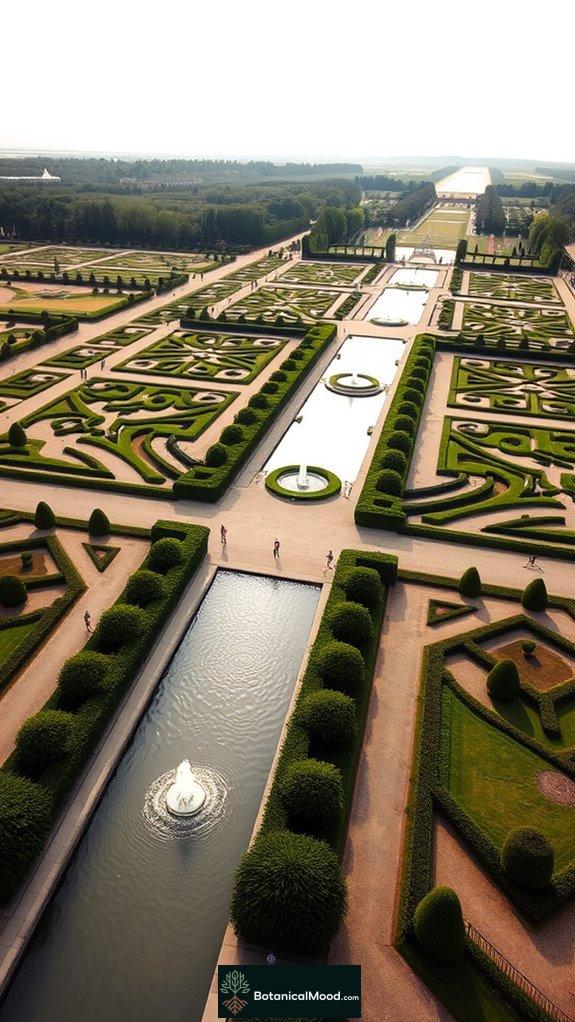
When you step into the Gardens of Versailles, it's like entering a living masterpiece, where every element is meticulously crafted to evoke a sense of elegance and grandeur. The symmetrical layout, influenced by Louis XIV's vision, embodies garden symbolism, reflecting power and authority. As I stroll along the grand axes, I admire the elaborate parterres and serene bosquets, designed by André Le Nôtre to create harmonious spaces for leisure. These historical influences not only shaped the gardens but also set a standard for European design, inspiring my passion for botanical beauty and leading me to create this website, Botanical Mood. The gardens contain over 600 fountains and 35 kilometers of canals, showcasing 17th-century hydraulic engineering.
The Gardens of the Château De Fontainebleau
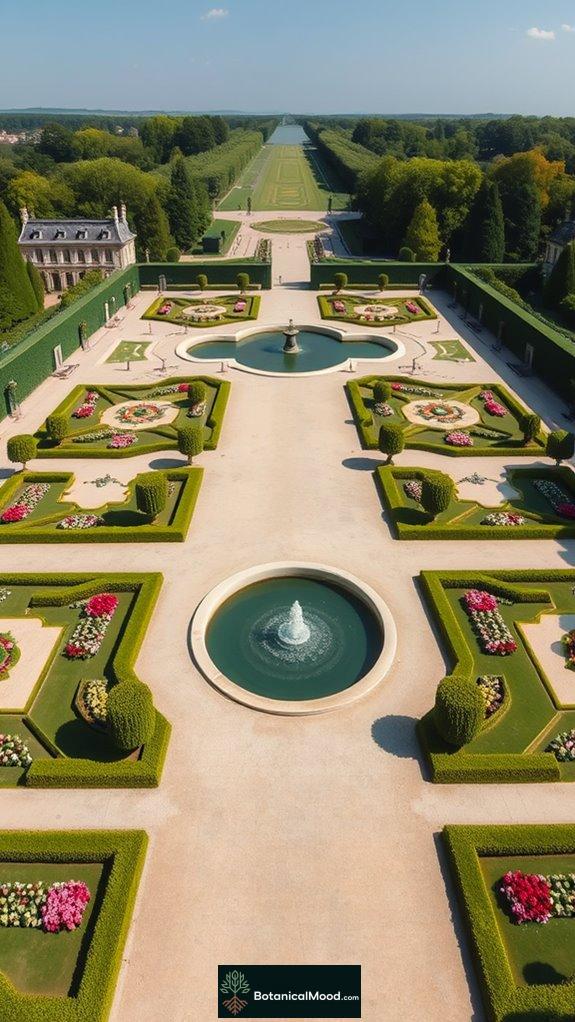
As I explore the Gardens of the Château de Fontainebleau, I'm captivated by their rich history and elaborate design, which has evolved over centuries.
From the formal gardens of Francis I to the Italian Renaissance influences brought by Catherine de' Medici, the garden evolution showcases royal influence at every turn.
The garden's evolution, from Francis I's formality to Catherine de' Medici's Renaissance touch, reveals a rich tapestry of royal influence.
André Le Nôtre's Grand Parterre, with its geometric designs and vibrant flowerbeds, reflects classical French aesthetics, while later transformations introduced English scenery elements, adding winding paths and exotic trees.
Each feature, from the impressive fountains to the serene water features, tells a story of artistry and dedication, inspiring my passion for garden design at Botanical Mood. The incorporation of medieval European landscape architecture in various elements of the garden further enhances its historical significance.
The Tuileries Garden: A Harmonious Blend of Nature and Art
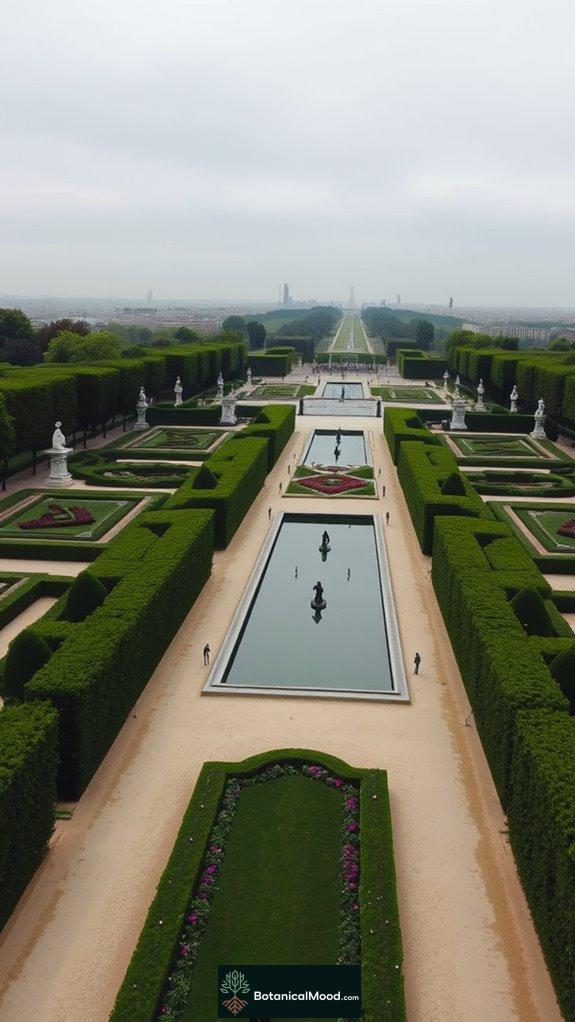
The Tuileries Garden, nestled in the heart of Paris, captivates visitors with its seamless blend of nature and art, inviting everyone to explore its meticulously designed scenery.
With its historical significance, originating from Catherine de' Medici's vision in 1564, the garden showcases artistic influence through André Le Nôtre's 17th-century redesign.
Symmetrical pathways, reflective pools, and exquisite sculptures create a harmonious atmosphere, mirroring the grandeur of the Louvre.
As I created Botanical Mood to celebrate such artistry, I find inspiration here, where every corner tells a story of France's cultural evolution, making it a must-visit destination for all garden enthusiasts.
The Royal Gardens of the Château De Chantilly
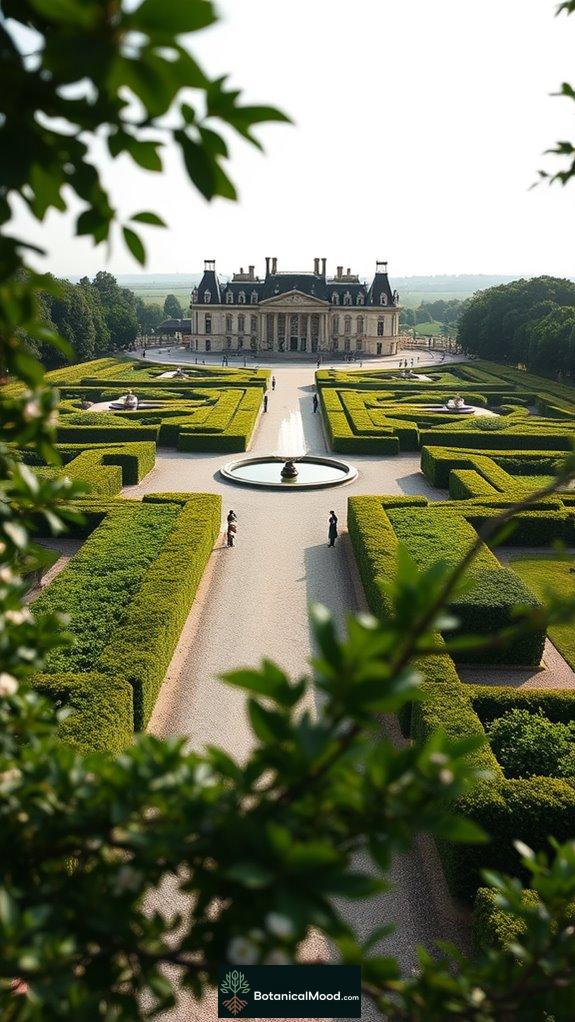
Nestled just a short train ride from Paris, the Royal Gardens of the Château de Chantilly present a breathtaking panorama of horticultural artistry and historical significance.
Spanning 115 hectares, these gardens showcase centuries of design, from André Le Nôtre's iconic 17th-century French-style garden to the romantic English Garden of the 19th century. The gardens exemplify French Baroque elements, which emphasize symmetry, grandeur, and the integration of nature with architecture.
After significant garden restoration efforts, particularly noted after its inclusion on the World Monument Watch List, the estate's grandeur is preserved beautifully.
Each element, from the stunning water features to the rustic hamlet of the Anglo-Chinese garden, reflects the rich Château history, inviting visitors like us to explore and appreciate this timeless beauty.
The Gardens of the Palais-Royal: A Timeless Classic

While wandering through the Gardens of the Palais-Royal, one can't help but feel a sense of history and elegance that permeates the air.
Wandering through the Palais-Royal Gardens evokes a profound sense of history and elegance in every breath.
This timeless classic showcases its historical significance and cultural influence through its design and features.
Here are three highlights:
- Laid out for Cardinal Richelieu, the gardens became a royal property, reflecting power and beauty.
- André Le Nôtre's redesign introduced innovative architectural elements that enhanced the garden's aesthetic appeal.
- Modern installations, like Buren's Columns, bridge past and present, inviting creativity in this public space.
This blend of history and innovation inspires my passion for garden design at Botanical Mood.
The Stunning Layout of the Château De Vaux-Le-Vicomte
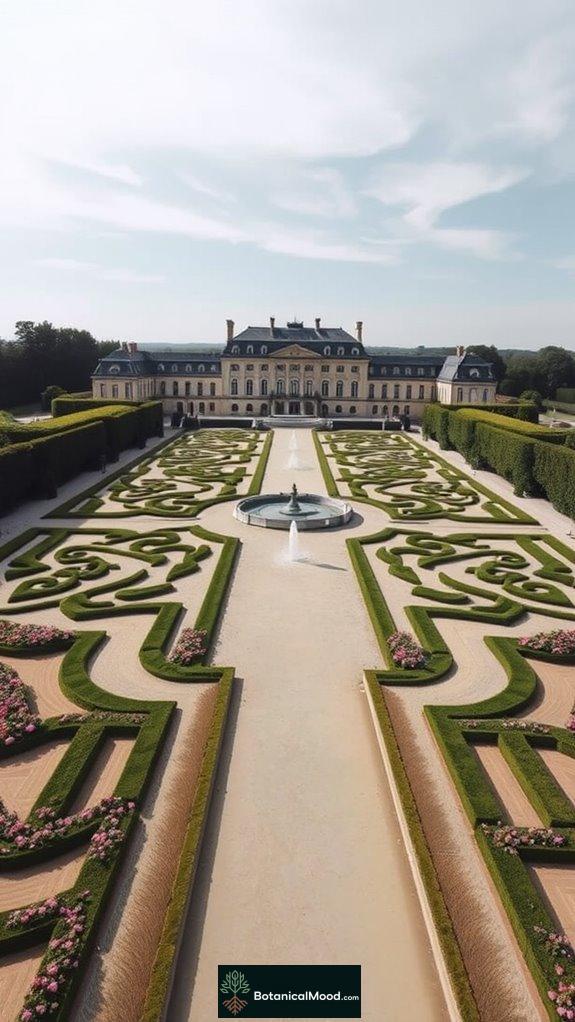
Few gardens can match the stunning layout of the Château de Vaux-le-Vicomte, a masterpiece that exemplifies the grandeur of 17th-century French formal garden design.
Crafted by André Le Nôtre, this garden showcases Baroque aesthetics through its symmetrical layout, elaborate patterned parterres, and harmonious collaboration with architecture.
Stretching along a three-kilometer axis, it creates a breathtaking visual experience.
The fountains, reflecting pools, and playful optical illusions invite exploration, making every visit a delightful journey.
Each detail reflects my passion for innovative garden design, which I aim to share through my website, Botanical Mood, inspiring others to appreciate these remarkable environments.
The Grandeur of the Gardens at the Château De Chenonceau
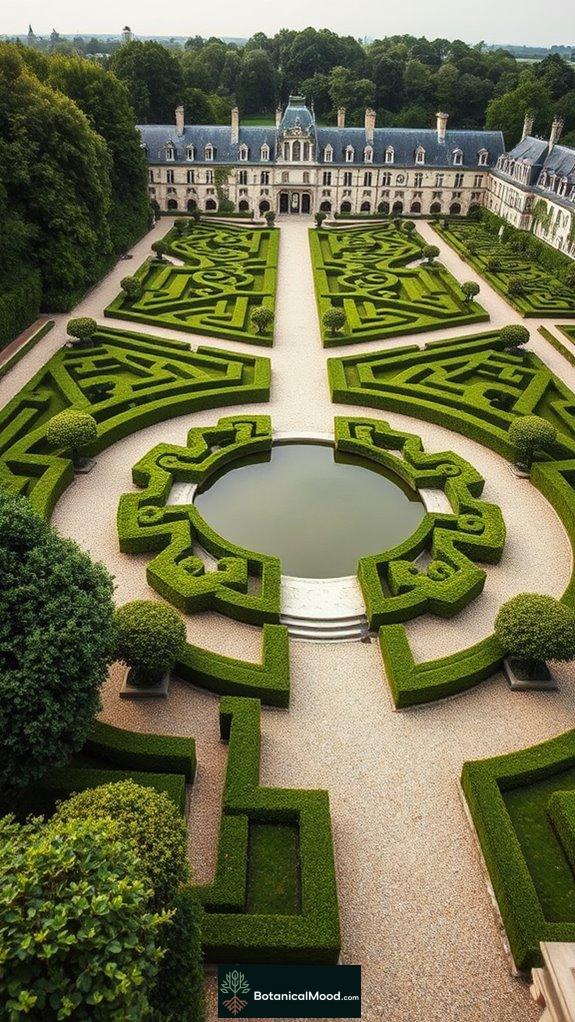
The gardens at the Château de Chenonceau, renowned for their exquisite beauty, truly captivate anyone who steps into this historical scenery.
With a rich history shaped by significant female influence, the gardens showcase remarkable garden evolution through:
- Diane de Poitiers' original design featuring stunning santolina scrolls.
- Catherine de Medici's elegant circular pond surrounded by meticulously arranged boxwood.
- Contemporary conservation efforts by skilled gardeners that maintain the Renaissance layout.
As I explore these gardens, I appreciate how they reflect the artistic vision of their female owners, blending nature and design in breathtaking harmony.
The Formal Gardens of the Château De Villandry

As I wander through the Formal Gardens of the Château de Villandry, I can't help but admire how each carefully curated section tells a story of artistic vision and dedication.
The Renaissance restoration, led by Joachim Carvallo, brilliantly revives the elegance of the 16th century.
The elaborate designs, formed by low box hedges, create a stunning backdrop for the ornamental vegetables that thrive in vibrant colors.
Each terrace, from the sun garden to the water garden, reflects a harmonious blend of symmetry and order.
It's this innovative approach to gardening that inspires my passion for sharing these botanical wonders through Botanical Mood.
The Serene Beauty of the Gardens at the Château De Amboise
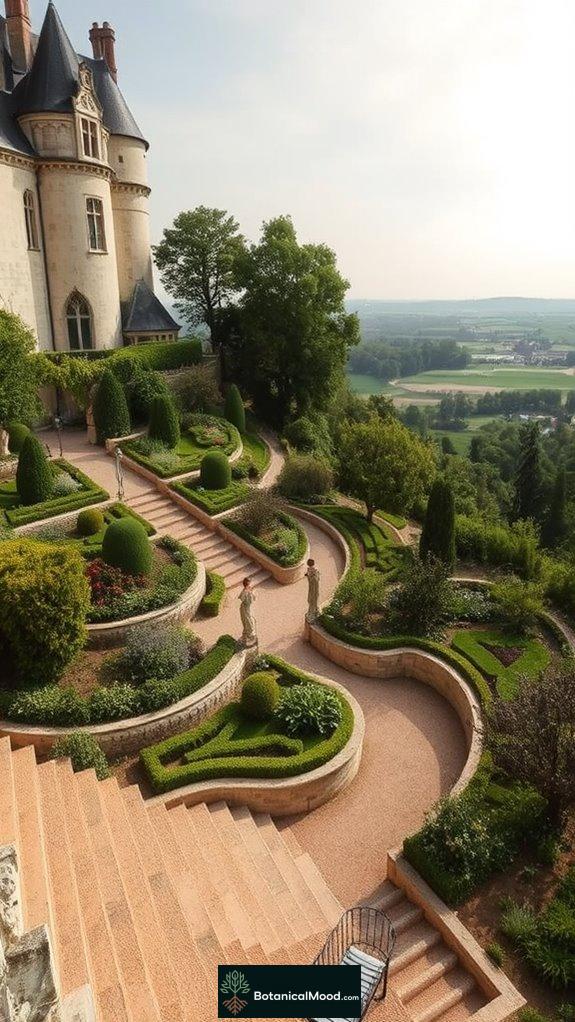
Wandering through the gardens at the Château d'Amboise, I'm immediately captivated by the tranquil ambiance that envelops this historic site.
The blend of historical significance and modern restoration creates a unique experience. I'm drawn to:
- The lush Mediterranean plants that infuse vibrant colors.
- The stunning views of the Loire Valley from the elevated terraces.
- The organic maintenance practices that emphasize sustainability.
Each element speaks to the careful design, honoring Dom Pacello's legacy while embracing innovative gardening techniques. The incorporation of native woodland plants enhances the natural beauty while supporting local ecosystems.
These gardens, with their rich past and fresh energy, inspire my passion for botanical beauty, a sentiment I cherish through my website, Botanical Mood.
The Magnificent Garden Design of the Château De Sceaux
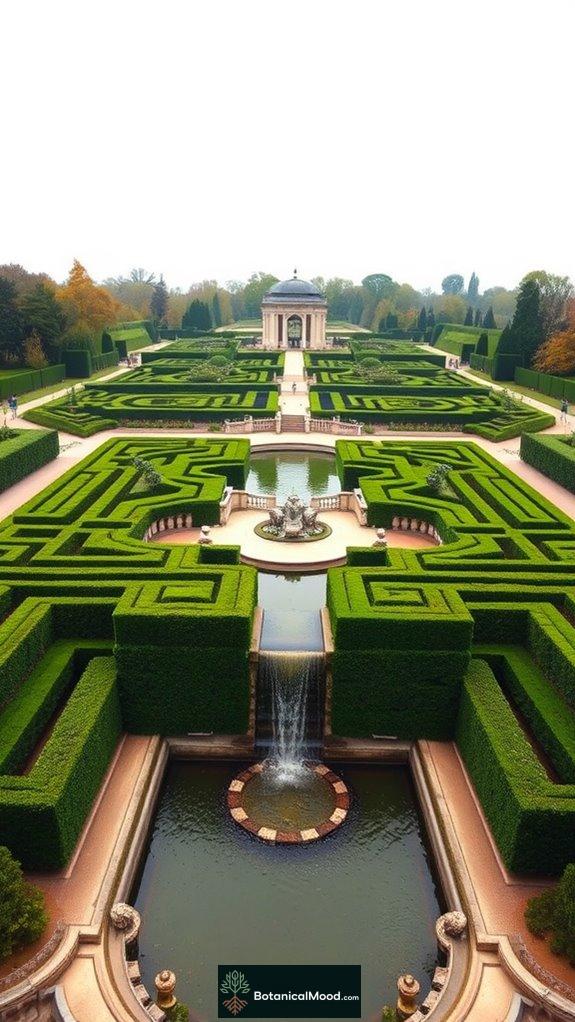
Exploring the gardens of the Château de Sceaux, I find myself immersed in a masterful display of scenery artistry that reflects the grandeur of French formal design.
Originally arranged by André Le Nôtre, the garden restoration has preserved its historical essence while emphasizing its cultural significance.
Originally designed by André Le Nôtre, the garden seamlessly blends historical charm with cultural importance through its careful restoration.
The terraced layouts and grand axis create a breathtaking symmetry, enhanced by the remarkable stone cascade and the iconic Grand Canal.
Notable architectural features, like the Pavillon de l'Aurore, demonstrate exquisite craftsmanship.
As I stroll through the meticulously designed paths, I appreciate how this estate continues to inspire and attract visitors worldwide, including those who share my passion at Botanical Mood. The layered evergreen structure of the garden offers year-round beauty, enhancing the visual interest even in winter months.
Symmetrical Pathways and Hedges
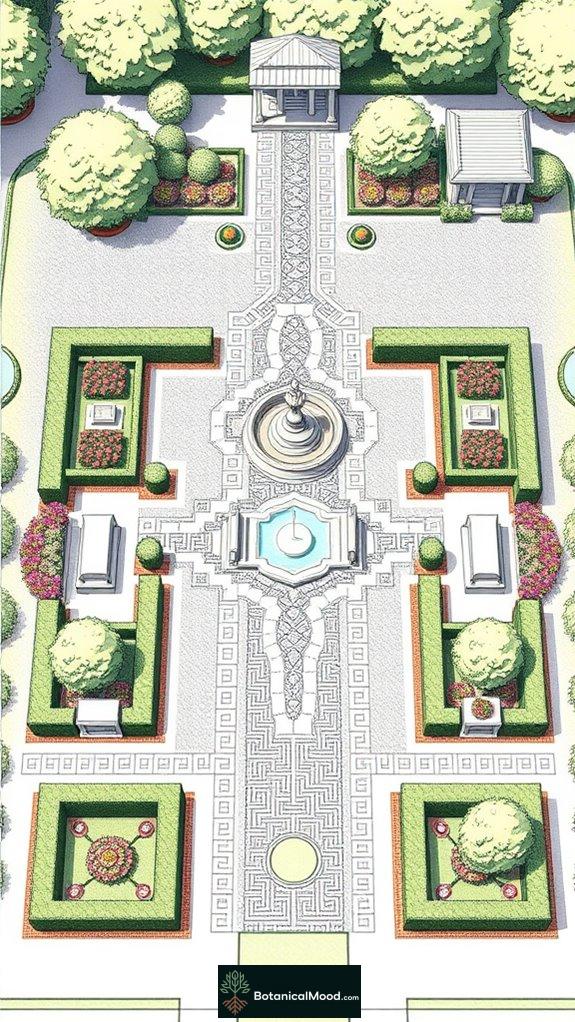
Symmetrical pathways and hedges form the backbone of French garden design, creating structured beauty that captivates the eye.
I've always appreciated how these elements promote harmony and order.
Here are three key features that define this style:
- Central Axis: Pathways often lead to a focal point, guiding the viewer's gaze.
- Neat Topiary: Structured hedges, like boxwoods, add elegance and maintain symmetry.
- Geometric Patterns: Gravel or stone pathways showcase stunning designs, enhancing visual appeal.
At Botanical Mood, I celebrate these design principles, emphasizing how they reflect classic French sophistication and innovation in garden aesthetics. The use of geometric landscape design is essential in achieving the balanced layout typical of formal gardens.
Elegant Water Features
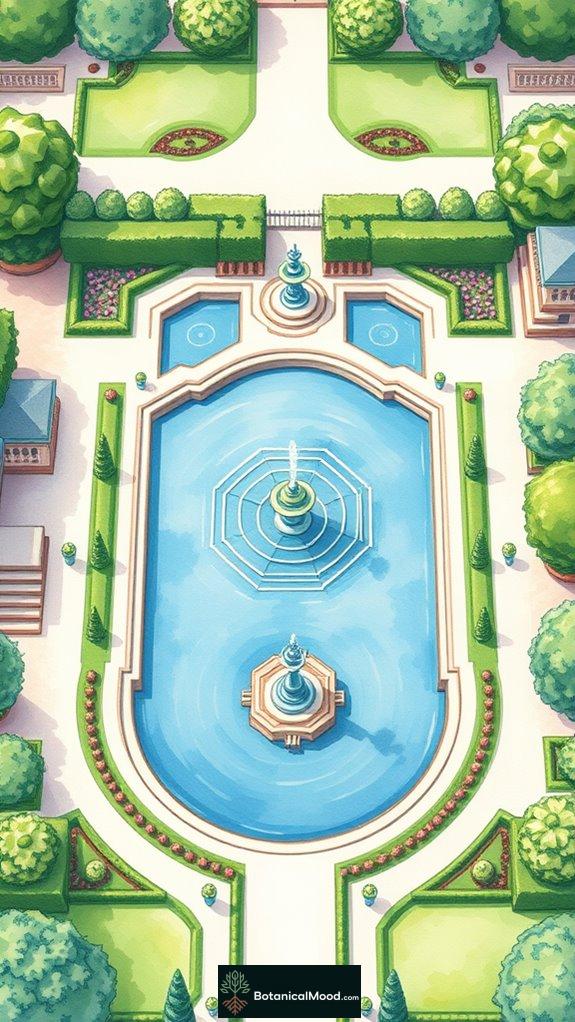
Elegant water features transform French palace gardens into serene sanctuaries, where the harmonious interplay of nature and artistry captivates all who visit.
These stunning elements, like the majestic fountains of Versailles, showcase water symbolism and the brilliance of hydraulic engineering. Each fountain, from the towering Dragon Fountain to the elegant Bassin d'Apollon, serves as a focal point, drawing the eye and reflecting the sky.
Water's reflective quality enhances the garden's beauty while reinforcing themes of power and artistry. Additionally, incorporating stunning outdoor fountain designs can elevate the overall aesthetic of any large garden space.
At Botanical Mood, I aim to inspire appreciation for these exquisite designs, reminding us how innovation can breathe life into our own environments.
Intricate Floral Patterns
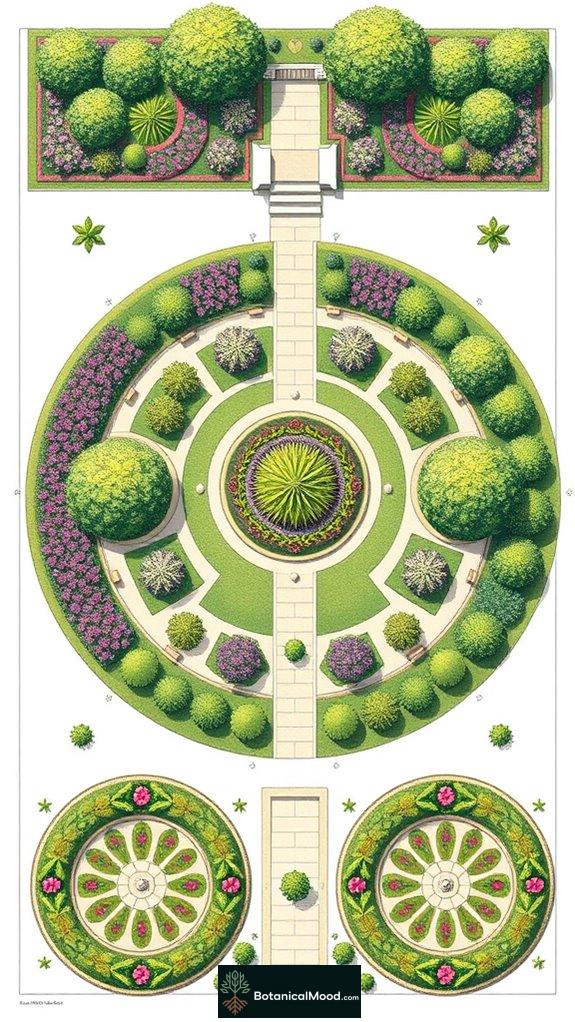
Complex floral patterns define the allure of French palace gardens, showcasing a meticulous blend of nature and human creativity.
These designs, embodying geometric precision, often feature:
- Symmetrical arrangements that evoke harmony.
- Parterres with elaborate shapes like ovals and circles.
- Vibrant plant choices, including lavender, that enhance floral symbolism.
Every element works in concert, from the boxwood edging to the meticulously shaped topiary.
Inspired by royal gardens like Versailles, I created Botanical Mood to celebrate such beauty. Additionally, understanding ornamental garden symmetry is crucial for achieving the elegance found in these grand layouts.
Each garden invites us to appreciate the balance between nature's spontaneity and human artistry, transforming vistas into living masterpieces.
Strategic Space Utilization
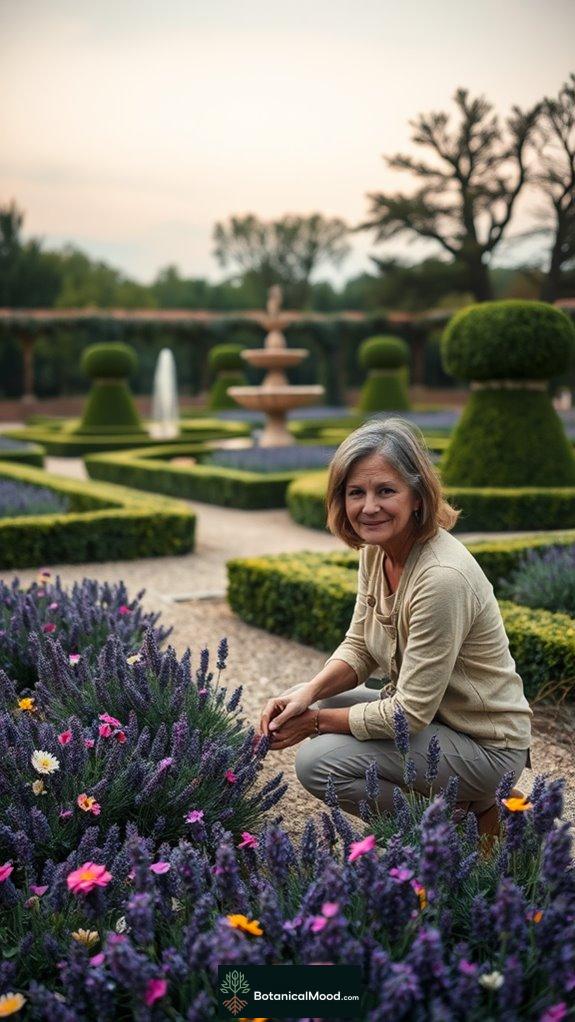
While exploring the grandeur of French palace gardens, one quickly realizes how strategic space utilization transforms these terrains into enchanting experiences. The layout emphasizes geometric order and spatial harmony, guiding visitors through carefully planned axes that intersect and direct attention.
Within these gardens, parterres, bosquets, and terraces establish layered designs, maximizing available space. Water features, like fountains and canals, not only enhance beauty but also serve multiple functions. These elements reflect historical garden layout principles that prioritize aesthetic and functional design.
Statues dot the scenery, creating focal points that narrate the garden's story. This meticulous design inspires me to curate Botanical Mood, where I celebrate such innovative environments that captivate the senses.
References
- https://bluprint-onemega.com/architecture/heritage/the-gardens-of-versailles-the-icon-of-french-landscape-design/
- https://dyckarboretum.org/gardens-of-france-versailles/
- https://www.theparisianguide.com/s/gardens-of-versailles/
- https://www.eyeofthedaygdc.com/2018/03/elements-french-garden-design/
- https://www.interiorcompany.com/in/trends/gardens-of-versailles-architecture
- https://en.wikipedia.org/wiki/Palace_of_Fontainebleau
- https://en.chateauversailles.fr/gardens-and-groves
- https://www.chateaudefontainebleau.fr/en/interactive-maps-of-the-castle-of-fontainebleau/
- https://www.ferretingoutthefun.com/2015/05/07/chateau-de-fontainebleau/
- https://www.chateaudefontainebleau.fr/en/explore-the-castle-and-gardens/discover-the-courtyards-and-gardens/
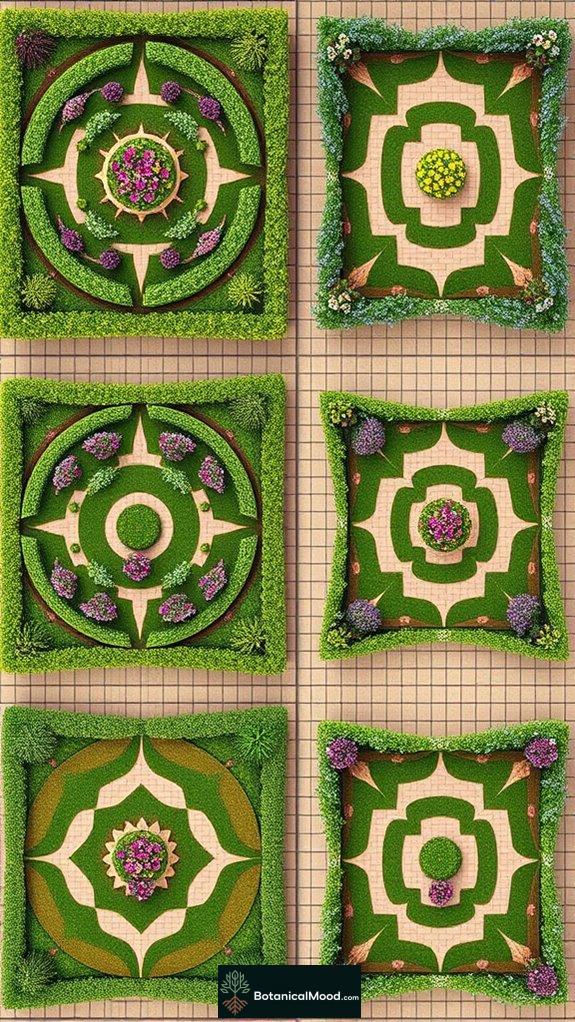
Leave a Reply